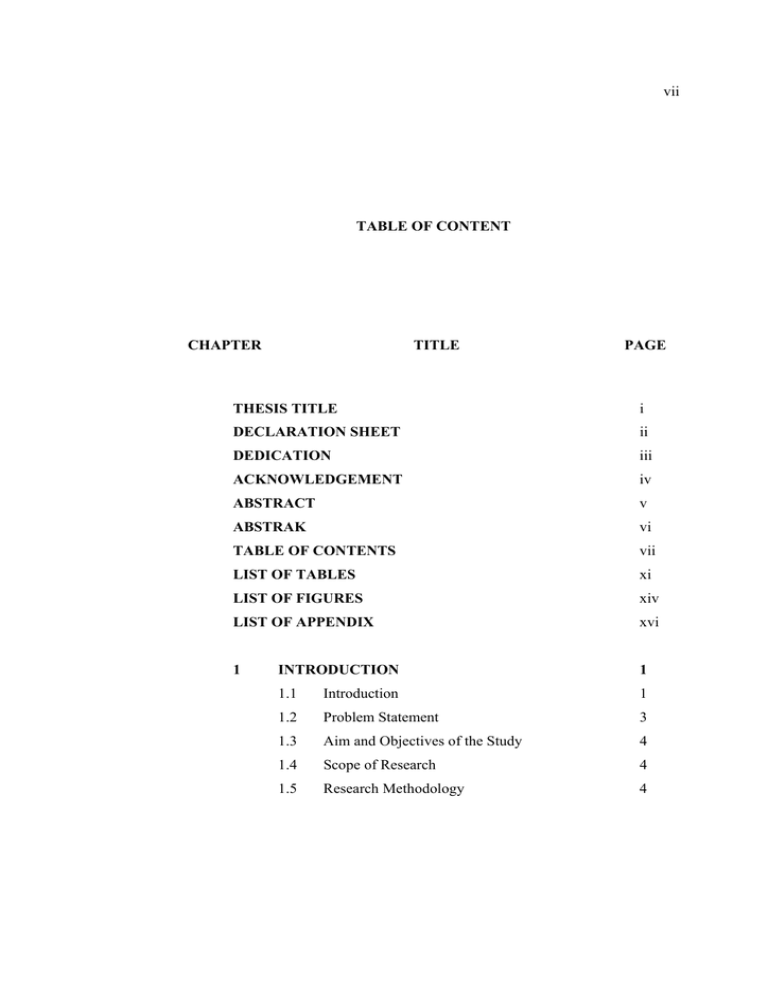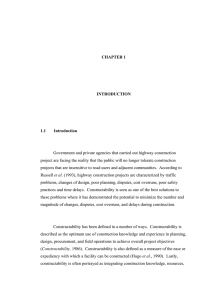vii i ii
advertisement

vii TABLE OF CONTENT CHAPTER TITLE PAGE THESIS TITLE i DECLARATION SHEET ii DEDICATION iii ACKNOWLEDGEMENT iv ABSTRACT v ABSTRAK vi TABLE OF CONTENTS vii LIST OF TABLES xi LIST OF FIGURES xiv LIST OF APPENDIX xvi 1 INTRODUCTION 1 1.1 Introduction 1 1.2 Problem Statement 3 1.3 Aim and Objectives of the Study 4 1.4 Scope of Research 4 1.5 Research Methodology 4 viii 2 LITERATURE REVIEW 6 2.1 Constructability Definitions 6 2.2 General Overview Constructability in 7 Highway Project 2.3 2.2.1 Government Agency Observations 8 2.2.2 Design Firm Observations 11 2.2.3 Construction Firm Observations 14 Constructability in the Highway 14 Construction Project Process 2.3.1 Feasibility Design Stages 16 2.3.2 Design Stages 17 2.3.3 Construction 18 2.3.4 Operation 18 2.4 Maximum Benefit of Constructability 19 2.5 Constructability Concepts in Highway Projects 22 2.6 Design Phase Constructability Concepts 32 2.6.1 Carry Out Thorough Investigation of the Site 34 2.6.2 Design for Minimum Time Below Ground 36 2.6.3 Design for Simple Assembly 39 2.6.4 Encourage Standardisation/Repetition 40 2.6.5 Design for Preassembly or Modularisation 40 2.6.6 Analyse Accessibility of the Jobsite 41 2.6.7 Employ Any Visualisation Tools 42 to Avoid Physical Interference 2.6.8 Investigate Any Unsuspected Unrealistic 42 or Incompatible Tolerances 2.6.9 Investigate the Practical Sequence of 43 Construction 2.6.10 Plan to Avoid Damage to Work by Subsequent Operations 43 ix 2.6.11 Consider Storage Requirement at 43 the Jobsite 2.6.12 Investigate the Impacts of Design on 44 Safety during Construction 2.6.13 Design to Avoid Return Visit by Trade 45 2.6.14 Design for the Skills and Resources 45 Available 2.6.15 Consider Suitability of Designed Materials 46 2.6.16 Provide Detail and Clear Information 45 2.6.17 Design for Early Enclosure 46 2.6.18 Consider Weather Effect in Selecting Materials or Construction Methods 2.7 3 48 RESEARCH METHODOLOGY 3.1 Introduction 50 3.2 Research Process 50 3.3 Determining the Research Objectives 51 3.4 Steps in Methodology 52 3.4.1 Conceptualization 52 3.4.2 Literature Review 53 3.4.3 Questionnaire 53 3.4.4 Analysis 56 Development of Guidelines 57 3.5 4 Summary 47 DATA ANALYSIS AND DISCUSSION 4.1 Introduction 58 4.2 Respondent’s Background 59 4.2.1 Type of Organization 59 4.2.2 Level of Education 60 x 4.3 4.4 4.5 4.2.3 Field of Specialization 61 4.2.4 Position in Organization 62 4.2.5 Numbers of Years Practiced in Designing 63 4.2.6 Numbers of Years Practiced in Working 64 Level of Importance 66 4.3.1 Frequency Analysis 66 4.3.2 Average Index Analysis 77 Level of Application 81 4.3.3 Frequency Analysis 81 4.3.4 Average Index Analysis 91 The Development of Design Phase 95 Constructability Improvement Concepts 4.6 5 Discussion 99 CONCLUSION AND RECOMMENDATIONS 5.1 5.2 Conclusion 100 5.1.1 Objective 1 100 5.1.2 Objective 2 104 5.1.3 Objective 3 105 Recommendations 105 REFERENCES 107 APPENDIX 110 xi LIST OF TABLES TABLE NO. TITLE PAGE 4.1 Type of Organization 59 4.2 Level of Education 61 4.3 Field Of Specialization 62 4.4 Position in Organization 63 4.5 Number of Years Practiced in Designing in 64 Highway Projects 4.6 Number of Years Practiced in Working in 65 Highway Projects 4.7 Carry out Thorough Investigation of the Site 66 4.8 Provide Detail and Clear Design Information 67 4.9 Analyze Accessibility of the Jobsite 67 4.10 Investigate the Impacts of Design on Safety 68 during Construction 4.11 Consider Suitability of Designed Materials 69 4.12 Investigate the Practical Sequence of Construction 69 4.13 Consider Adverse Weather Effect in Selecting Materials 70 or Construction Methods 4.14 Plan to Avoid Damage to Work by Subsequent 71 Operations 4.15 Investigate Any Unsuspected Unrealistic or 71 xii Incompatible Tolerances 4.16 Designs for the Skills and Resources Available 72 4.17 Consider Storage Requirement at the Jobsite 72 4.18 Design for Minimum Time below Ground 73 4.19 Design for Early Enclosure 73 4.20 Encourage Standardization/Repetition 74 4.21 Employ Any Visualization Tools to Avoid 74 Physical Interference 4.22 Design for Simply Assembly 75 4.23 Design to Avoid Return Visit by Trade 76 4.24 Design for Preassembly and/or Modularization 76 4.25 Average Index Value for Degree of Importance of 79 Constructability Concepts during the Design Phase 4.26 Carry Out Thorough Investigation of the Site 81 4.27 Employ Any Visualization Tools to Avoid 82 Physical Interference 4.28 Encourage Standardization/Repetition 82 4.29 Consider Storage Requirement at the Jobsite 83 4.30 Design for Minimum Time below Ground 83 4.31 Investigate the Practical Sequence of Construction 84 4.32 Design for Simply Assembly 84 4.33 Design for the Skills and Resources Available 85 4.34 Investigate the Impacts of Design on Safety during 86 Construction 4.35 Analyze Accessibility of the Jobsite 86 4.36 Design For Preassembly and/or Modularization 87 4.37 Investigate Any Unsuspected Unrealistic or 87 Incompatible Tolerances 4.38 Design to Avoid Return Visit by Trade 88 4.39 Design for Early Enclosure 88 4.40 Provide Detail and Clear Design Information 89 xiii 4.41 Plan to Avoid Damage to Work by Subsequent 89 Operations 4.42 Consider Suitability of Designed Materials 90 4.43 Consider Adverse Weather Effect in Selecting Materials 90 or Construction Methods 4.44 Average Index Value for Degree of Application of Constructability Concepts during the Design Phase 93 xiv LIST OF FIGURES FIGURE NO. TITLE PAGE 1.1 Research Methodology Chart 5 2.1 The Highway Construction Project Process 16 2.2 Project Life Cycle and Designers Level of Influence 20 2.3 Ability to Influence Final Cost Over Project Life 21 2.4 Process of launching girder for elevated structure 35 2.5 Problems faced during launching of some girders 35 2.6 Details of elevated highway 37 2.7 Problem of compaction and result after 38 project start-up 3.1 Steps in Methodology 52 3.2 Questionnaire Flow Chart 55 4.1 Percentage of type of organization 60 4.2 Percentage of level of education 61 4.3 Percentage of field of specialization 62 4.4 Percentage of Position in Organization 63 4.5 Percentage of Number of Years Practiced in 64 Designing In Highway Projects 4.6 Number of Years Practiced in Working in 65 Highway Projects 4.7 Degree of Importance of Constructability Concepts 80 xv 4.8 Degree of Application of Constructability Concepts 94 4.9 Design Phase Constructability Improvement Concepts 96 For Malaysian Highway Projects xvi LIST OF APPENDIX APPENDIX A TITLE Questionnaire Form PAGE 110

